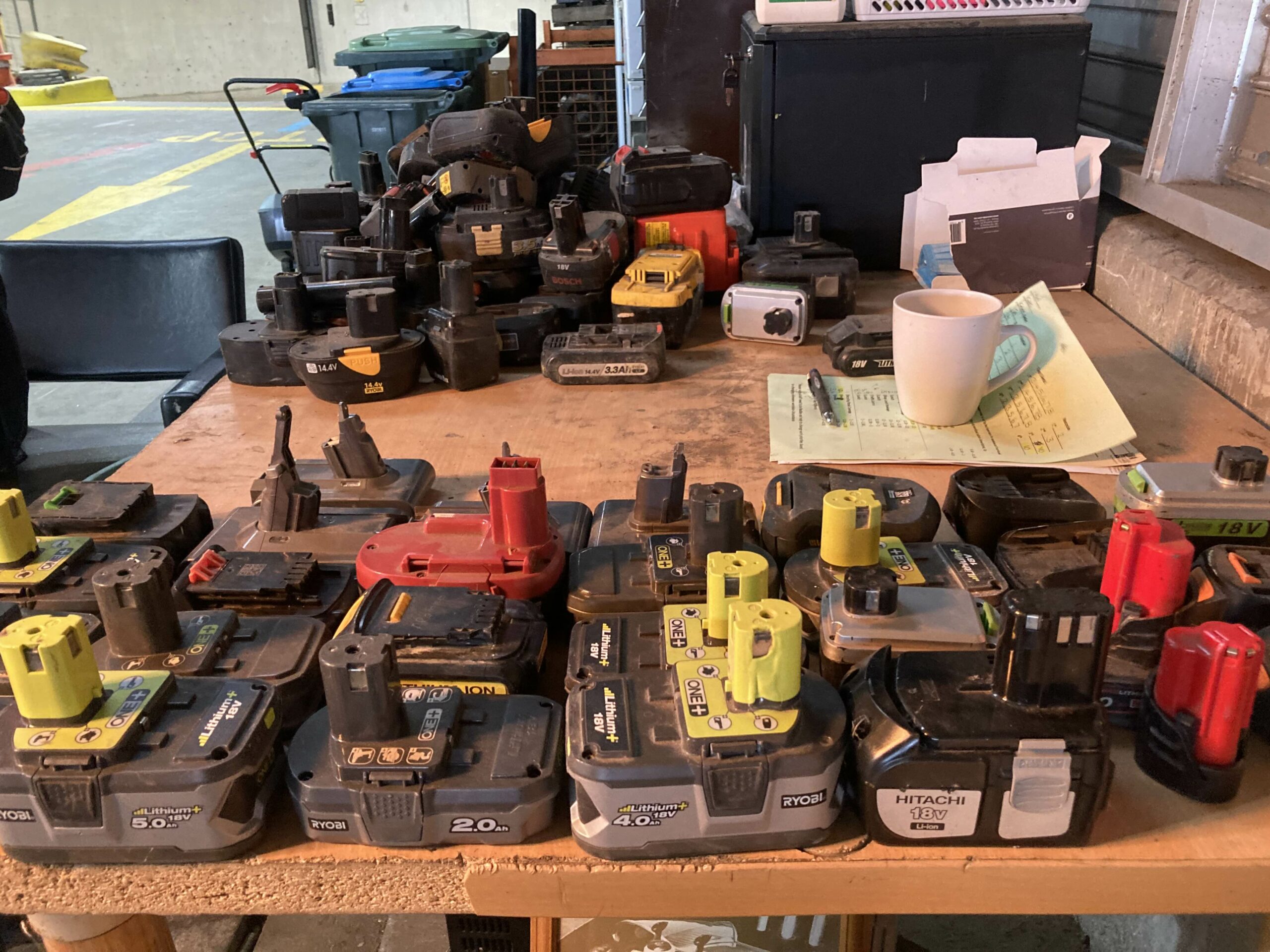We have found that a shocking volume of lithium-ion battery (LIB) waste has potential for a second life powering electronics in less demanding applications.
Important: This research is for informational purposes only and is not intended for personal use. Incorrect use or reuse of any battery, including lithium-ion, can cause fire, explosion, or death. Do not attempt to replicate this research or handle these materials at home. Always consult with professionals.
Many people are familiar with the sources of these LIBs, which include, but are not limited to, ailing battery packs that power common small appliances such as cordless vacuum cleaners and power tools. These are increasingly found in homes and businesses. Typically, after a few years of use the user will notice a significant drop in the battery capacity leading to the tool not lasting long enough between charges. Once the tool can no longer complete the job it was originally purchased for the user usually discards the old battery pack and replaces it with a new one, or in some cases may not realise the pack is replaceable and replaces the whole appliance.
Key Points
- Our Sustainability Victoria funded project ‘New Life for Resource Recovery Centre Harvested Lithium Ion Batteries’ set out to look at the commercial potential for the intermediate step of LIB cell reuse before disposal/recovery
- Our research found that 59.41% of all extracted cells retained more than 80% of their original capacity
- There are serious safety measures that must be taken to ensure reuse is compliant with relevant safety regulation and under no circumstances should LIB reuse involve simply stringing together cells without intermediate electronics that monitor conditions and control individual cells
- These useful ‘dead’ cells are high value in that they contain hard to source minerals that are already mined, refined, processed and manufactured into cells
- Reuse, before recycling is a core part of a circular economy
Data Collection
We disassembled 50 discarded battery packs from various manufacturers focusing on a common industry standard size li-ion cell called an 18650. 202 cells were extracted. Our extraction process was as follows:
- Collect cells from a local resource recovery centre, as shown in the feature image of this article
- Exclude packs that appear to be excessively damaged externally or with signs of water damage
- Carefully dismantle pack
- Exclude any pack showing signs of internal damage
- Extract cells
- Recorded initial voltage
- Test capacity of cells with initial voltage of 2.5 volt or greater using a commercial charger
Results
We found 59.41% of the 202 cells we extracted still had a capacity of 80% or greater.
- Of the 202 cells, 71.29% (144) were determined testable for a capacity check
- Of the 144 cells, 84.62% still had more than 80% capacity
- We have analysed, graded and documented the ease of dismantlement of packs from 16 different manufacturers, which will be the topic of a future article
Lithium-Ion Battery Waste Statistics
The CSIRO have best described the state of LIB waste in Australia:
- Only 10% of Australia’s lithium-ion battery waste was recycled in 2021, compared with 99% of lead acid battery waste
- Lithium-ion battery waste is growing by 20 per cent per year and could exceed 136,000 tonnes by 2036
- Lithium-ion batteries are a source of many valuable materials. If recycled, potentially 95% of battery components can be recovered for alternative use or may even be turned into new batteries
- Before the 2019 introduction of a national ban on landfill followed by a 2022 battery collection system, only a small percentage of EoL Li-batteries was collected and shipped overseas for processing. Currently, there is very little capacity in Australia for processing Li-batteries and large volumes are stored in warehouses and scrap yards, creating a serious fire risk and potential for environmental contamination.
- There is currently very little capacity in Australia for processing Li-batteries and large volumes are stored in warehouses and scrap yards, creating a serious fire risk and potential for environmental contamination.
Safety and the Case for LIB Reuse
We need to be clear here, there is a very good reason for a lack of LIB reuse in the industry. There is increasing concern that even new LIBs can be volatile and cause a fire or explosion. Reuse of mixed manufacturer and mixed capacity cells only increases that risk. Naturally then, the accepted wisdom is to only use certified new cells from the same manufacturer and batch to ensure the cells are well matched to each other.
However, safe reuse is possible and should be seriously considered. The CSIRO points out there is a major lack of Australian lithium-ion recycling infrastructure causing stockpiling that carries the risk of fire and environmental contamination. For this reason alone we should be reducing that stockpile and delaying the need to recycle. Imagine removing 59% of the LIB waste stream and the pressure that would take off the system.
This doesn’t even take into account the relative scarcity of these resources and the energy and pollution that goes into the mining, refining, processing and manufacturing these cells
A Lithium-Ion Reuse Solution
The second part of our project is to attempt to contribute a solution in the form of a battery management system that can handle mixed manufacturer and mixed capacity cells. We have made great strides in this area and will be back here to publish the results as we wrap up the project.
